How C-Suite Leaders Are Staying Competitive With RPA
Share at:

day, 70% of CEOs report Robotic Process Automation (RPA) and artificial intelligence (AI) as two of their highest priorities when thinking about meeting strategic objectives, according to a recent survey from The Economist.
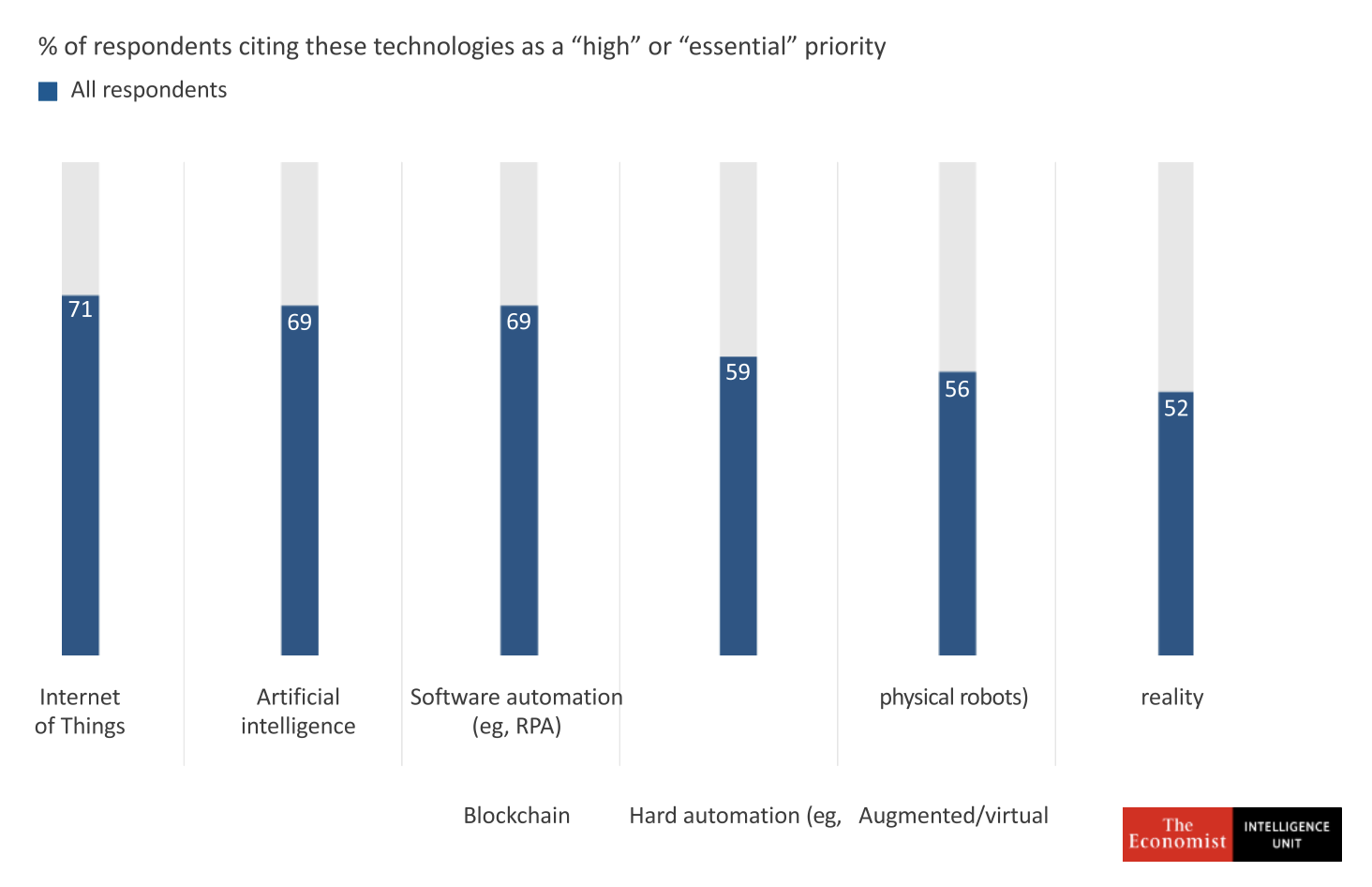
RPA’s rank as a top concern for the C-suite comes as no surprise.
After all, the C-suite’s job isn’t just to manage the organization today but to carve out its future.
In 93% of the companies surveyed, automation kicked off an organization-wide digital transformation.
Plus, 92% of C-suites around the world use RPA to help their companies provide better service to customers and increase customer satisfaction. RPA helps them gain an edge on competitors and better adapt to a rapidly transforming world.
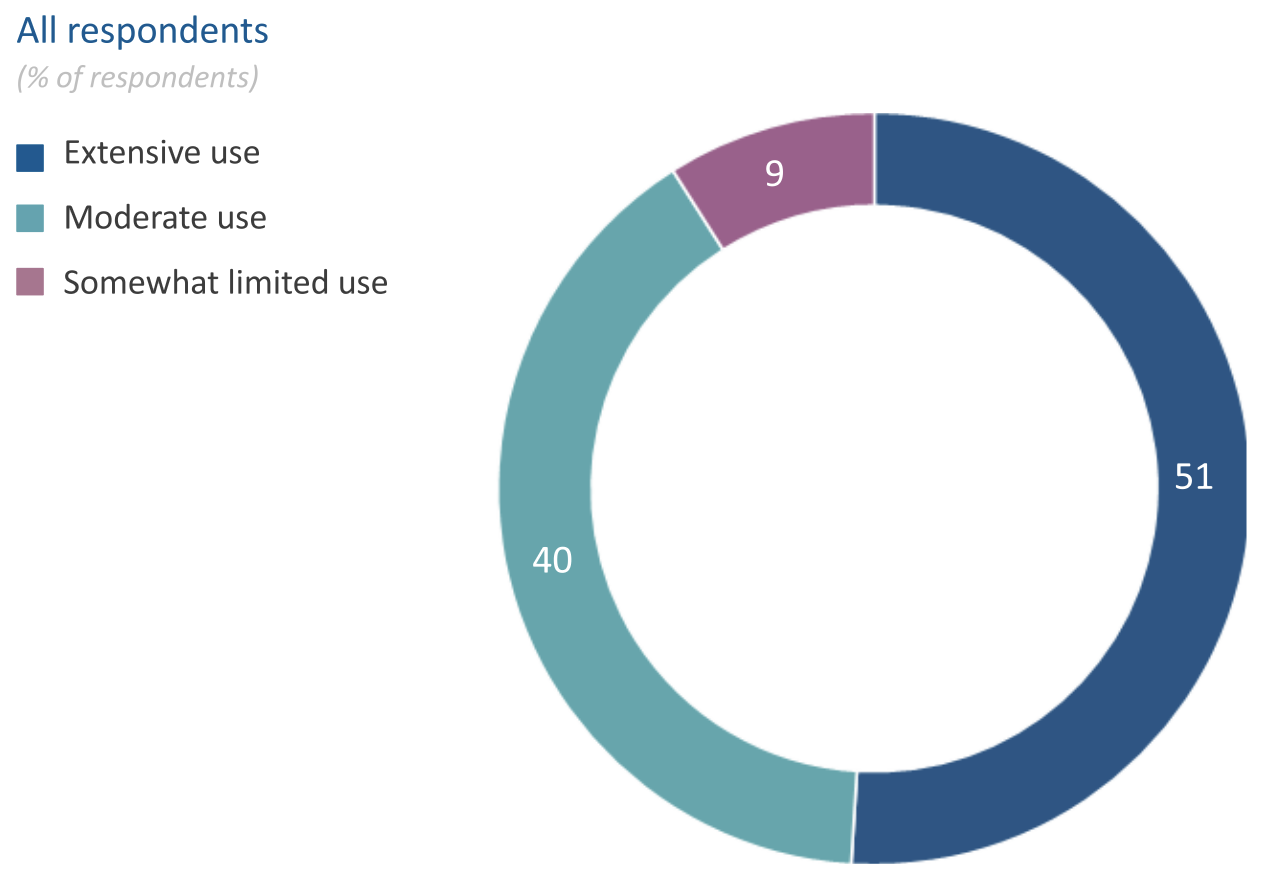
More and more business leaders are using RPA every day, and once they realize the benefits of automation they’re eager to scale.
The ‘automation first’ era has arrived. Companies—and C-suites—that can’t adapt their mindset will get left behind by the companies that can.
Join me and Emily Wasik, Thought Leadership Editor at the Economist, for a webinar packed with insights on how leading businesses are using this mindset to win in their markets
Why the C-suite drives the evolution of RPA
In a recent study by The Economist Intelligence Unit, 83% of respondents reported that the C-suite is driving automation initiatives. These respondents represent director and C-suite positions at companies with more than $250 million in annual revenue.
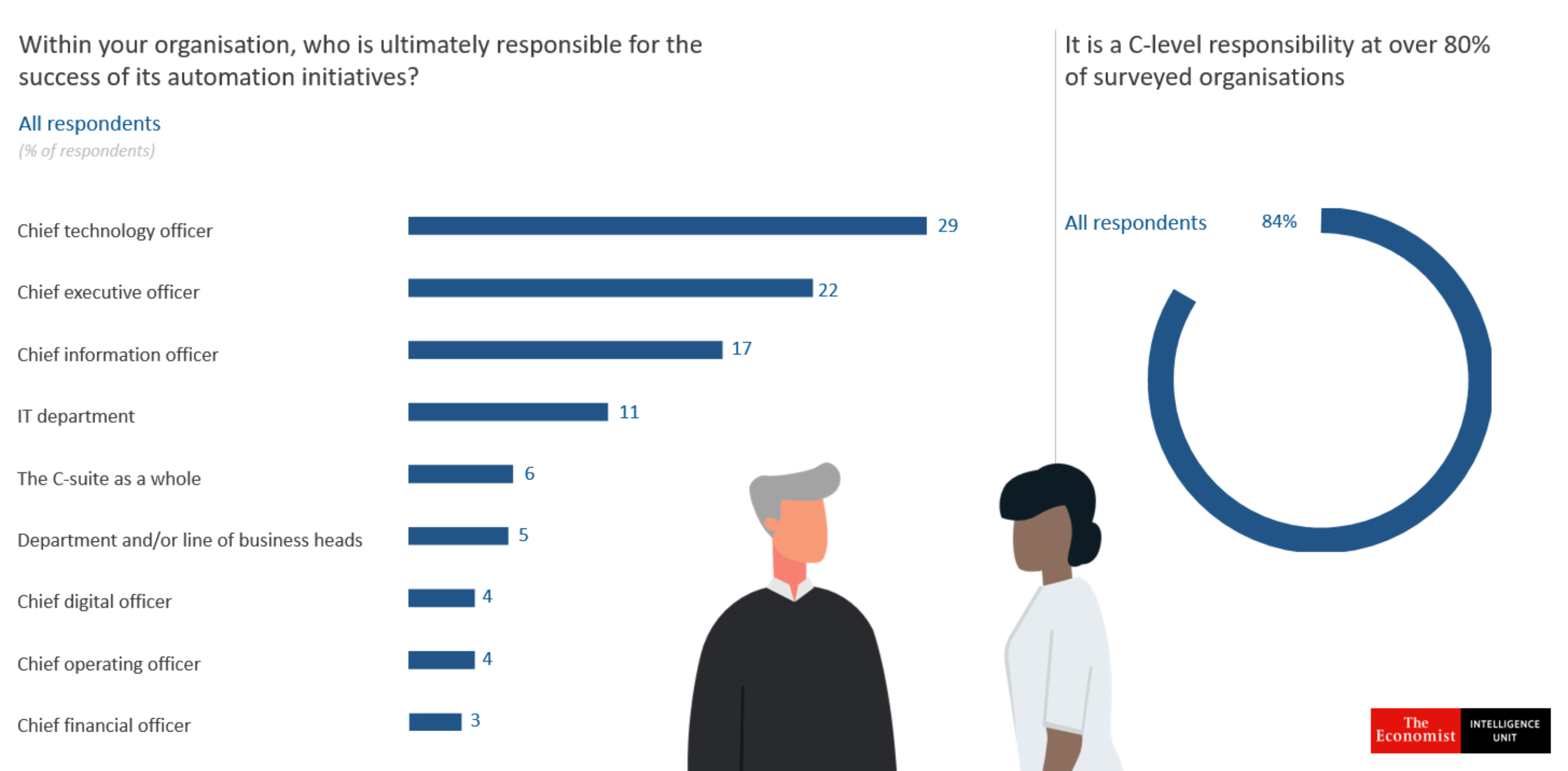
An additional 22% of those who said RPA drove strategic goals were CEOs, and 29% were chief technology officers (CTOs).
What these results tell us is that C-suites see RPA and automation as a priority and are ready to do what it takes to reap the benefits.
So, why is the C-suite so invested?
It comes down to their competitive drive and their need to look at how their company will stay ahead both now and in the future.
C-suite executives know that lagging can mean the death of their business. This creates a fear of missing out on technology that drives them relentlessly toward innovation. History has shown that if you don’t adapt, you’ll fall behind, such as Borders and Blockbuster.
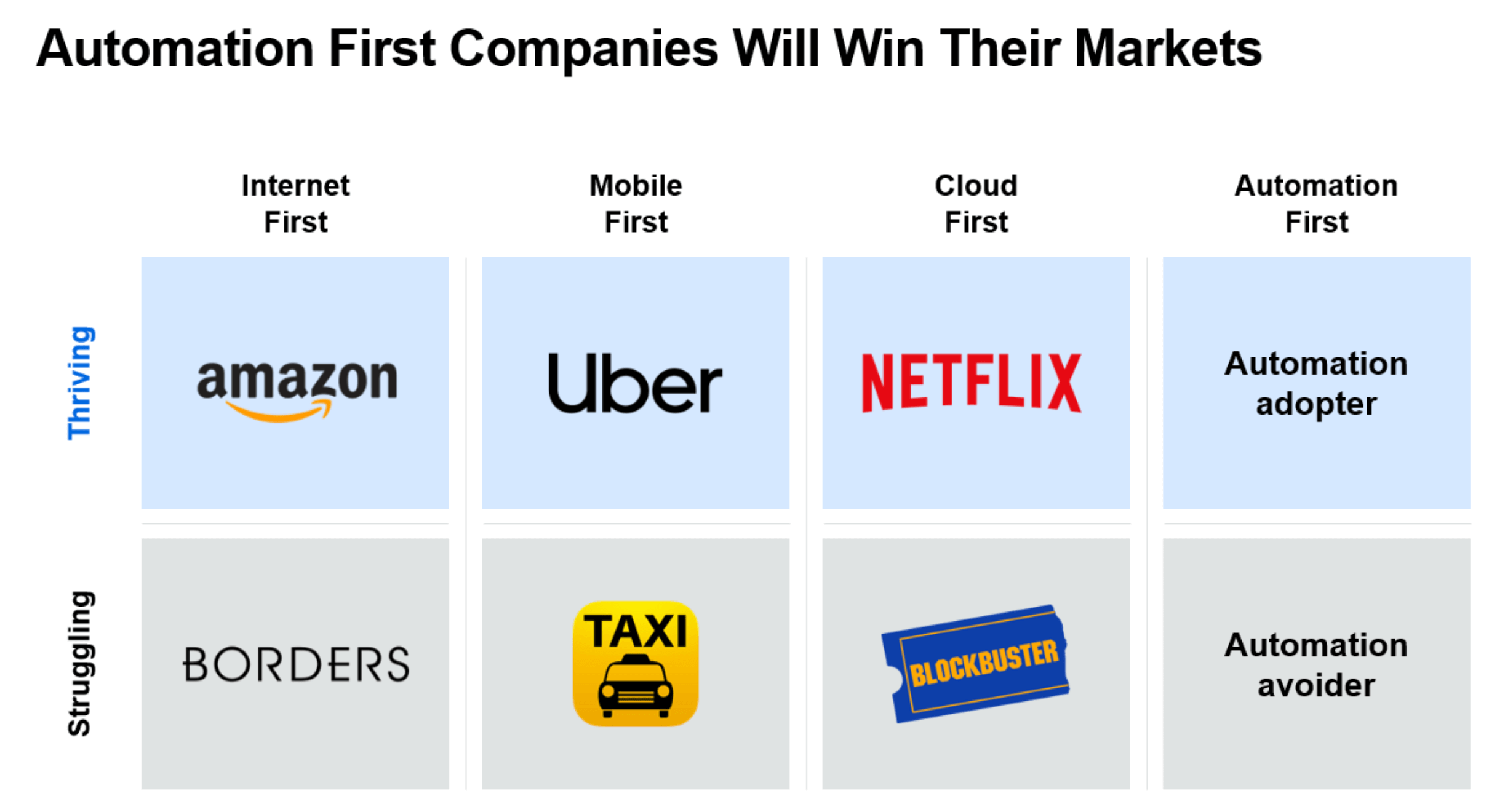
"There are winners and losers in every technological era. As we’ve seen with the internet, mobile, and cloud-first eras, those that don’t adapt get left behind."
Today, new challenges call for companies to adapt even faster and make new technologies even more critical to success.
As the cost of talent rises, companies are getting smarter about becoming more efficient through the use of new technology. RPA and AI not only help these companies become more competitive, but they also ensure happier and more productive employees and customers.
Automation frees employees from tedious and repetitive work, allowing them to focus on more creative, innovative, and higher-value work. This empowers employees and permits companies to increase business volume and drive the organization forward.
In years past, the C-suite may have narrowed in on reducing labor costs and helping the bottom line. However, the industry is shifting, pushing leadership to track progress through the improvement of other areas of their business.
These benefits are a big reason why 50.6% of company leaders have started using RPA extensively across their organizations. While the leaders of the past may have focused on new technologies to pad the bottom line, the C-suite of today recognizes that automation is about more than that.
It’s about progress and quality of life and work.
From the survey, 88% of respondents believe that automation will accelerate human achievement. Where people used to fear robots, 79% now recognize that automation works best when paired with humans, not against them.
By designing and implementing software robots that complement human operations, C-suite leaders show they’re focused on:
Increased productivity
Error reduction
Customer experiences
Reducing expenses
No longer do business leaders look to new tech to solve specific, isolated problems. Instead, 62% believe that automation will make them more competitive.
What C-suite leaders must consider when implementing automation
Some companies start their RPA journey by looking for “low-hanging fruit” tasks that can be quickly automated. However, succeeding with RPA long-term means approaching tasks with an automation first mindset. This calls for the C-suite to rethink, from the ground up, how their business can work with robots.
You have to start by asking yourself some vital questions:
What can be fully automated?
What tasks would benefit from a blend of robots and humans working together?
What problems will automation solve?
While we believe in a robot for every person, automation doesn’t need to take over every task and workflow. Instead, each organization’s needs will call for a unique kind of robot-human partnership. Traditionally, there are five options companies use as the base of such a strategy:
Attended, interval
Attended, in tandem
Hybrid
Partially unattended
Fully unattended
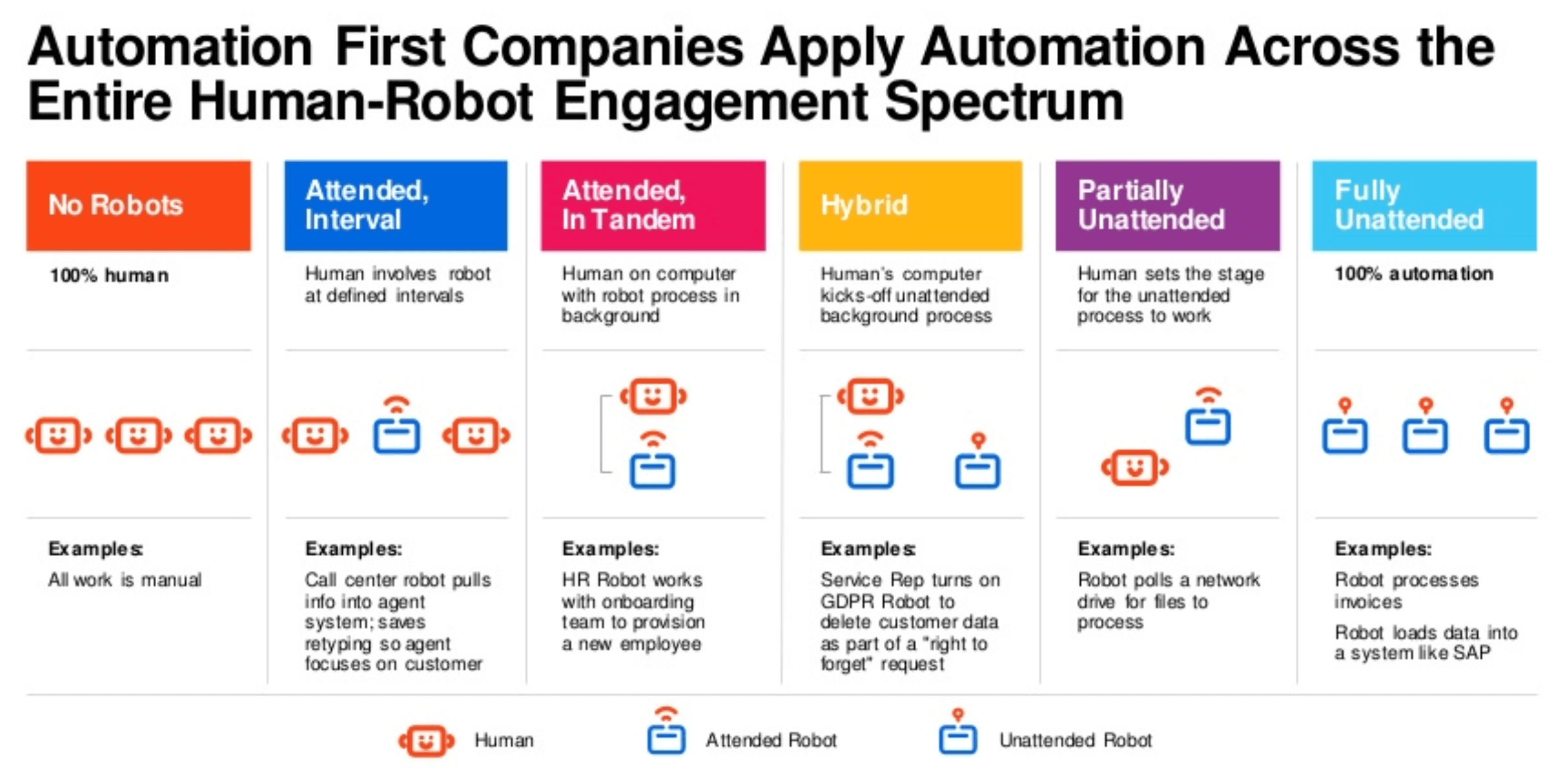
These automation scenarios help you build strategies that account for occasional, interval-driven automation through 100% automation workflows. RPA has the flexibility to adjust to the needs of each organization and team.
Your automation strategy will also depend on the processes you need to automate from the beginning.
While RPA can have a hand in improving any process across your organization, here are a few process examples that helped our customers realize ROI:
Compliance: Companies in industries with high regulation can use RPA to ensure compliance, eliminating costly human error. Robots help organizations handle large volumes of important tasks like negative news screenings, beneficial owner extraction, and other enhanced client due diligence (CDD) where errors can mean severe financial and legal consequences.
Data processing: The road to growth comes with a lot of data. Processing that data in a way that is logical, accessible, and scalable stumps many companies. RPA can alleviate this. In banking, for example, companies have used automation to review, process, sort, and find data from emails, client contracts, International Swaps and Derivatives Association (ISDA) documents, trade documents, and more.
Customer experience: Often, customer service agents spend more of their time per day navigating CRM systems than they do working with a customer. Instead, automation can be used to cover the mundane information-gathering work. In this vein, Morrison Utility Services used UiPath Robots to save 320 hours of labor per month, resulting in an estimated £145k in annual cost savings.
Invoice processing: Automating aspects of invoice processing limits the need for manual human review, leading to faster processing time and higher savings in labor. At Clariant, RPA enabled them to automate nearly half of their invoice processing, leading to a more efficient shipping process and eliminating 40,000 printouts per quarter.
Finally, like the direction of your company overall, the vision and priorities of your C-suite will drive your automation journey. This is where you get to take a step back from numbers-driven initiatives and think about how automation will drive what you value, what makes your company unique, and how your product and service will impact the world for years to come.
Will you, like 51.5% of C-suite leaders surveyed, use RPA to drive increased productivity, accelerating what your workforce can do in a day?
On the other hand, will you join the 31.5% who use automation to realize error-reduction goals, making operations more accurate and efficient?
The possibilities of what can be done with automation are only limited by the aspirations of your business.
RPA benefits compound over time
When you think automation first, RPA brings on a domino effect of positive changes. RPA reduces manual effort, which results in increased productivity. Higher productivity leads to accomplishing more with the same resources. Accomplishing more leads to happier customers and happier employees.
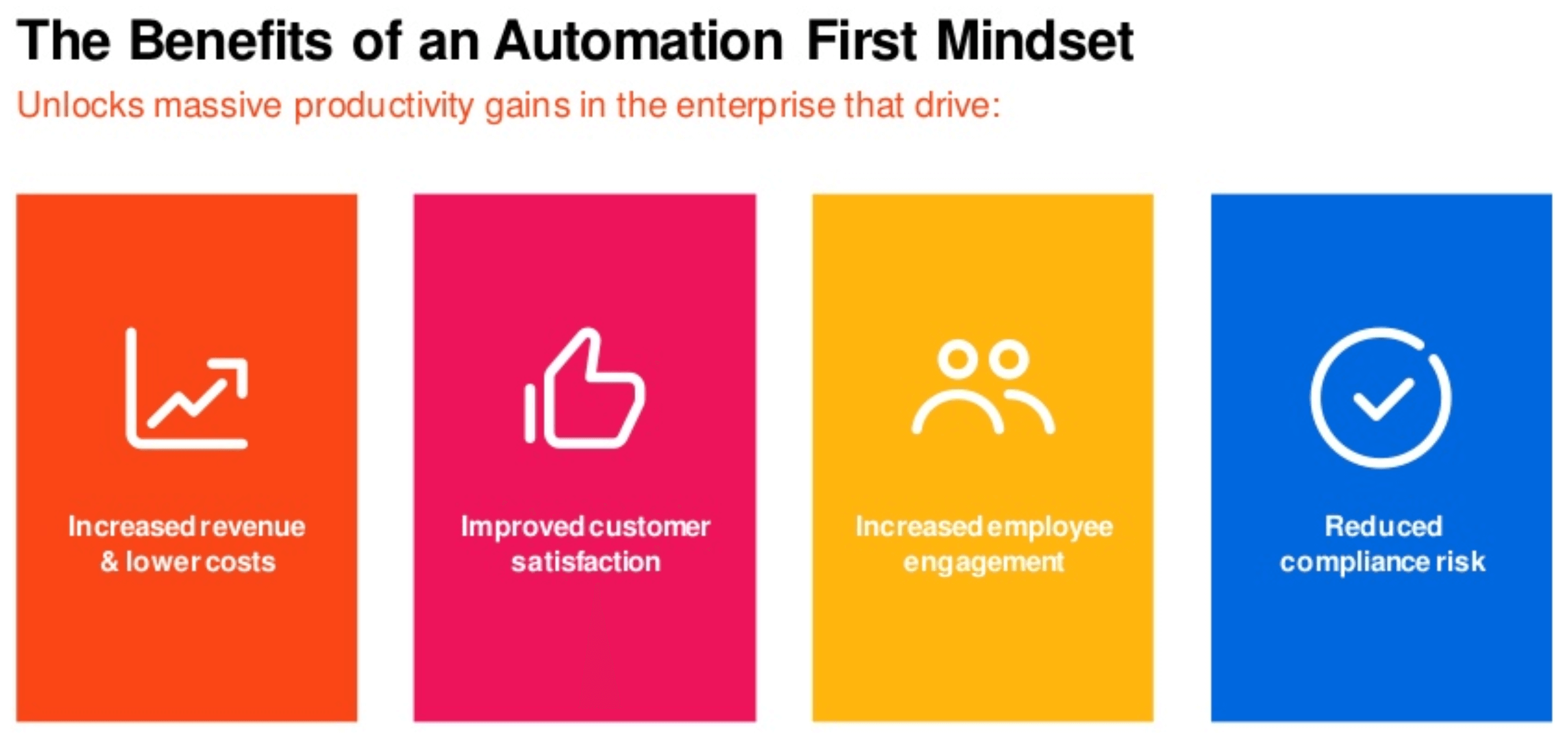
These goals don’t just provide one-time payoffs. They foster changes that benefit your company long into the future.
Automation also works to process more information in a shorter amount of time. This benefit goes beyond impressive metrics on a spreadsheet, as the Trelleborg Municipality Department of Welfare has seen.
The department’s employees provide exceptional service to help Swedish citizens regain control over their lives, but manual work slows them down. By automating their welfare-payment application process, the department could help 22% more people than in previous years.
This didn't just help recipients, but boosted employee morale, too.
People don’t enjoy the tedious parts of their jobs; they enjoy the parts that are cognitively challenging and rewarding.
With automation, employees create more genuine, longer-lasting relationships with customers, improving loyalty, retention, and happiness with your company.
According to The Economist, this rang true for 92% of C-suites surveyed in the long term, too. Additionally, 88% reported increased customer engagement over time.
As C-suites shift their vision from the low-hanging fruit goals of early RPA to longer-term strategic automation goals over the next two years, these kinds of benefits shed light on people-focused benchmarks such as:
Increased productivity (43% reported this as their main objective)
Improved consistency of service (27.7% reported this as their main objective)
Enhanced customer experience (25.7% reported this as their main objective)
Companies now realize that automation isn’t just a way to stay competitive in their industries, but rather the way to keep up with the competition.
When RPA becomes a C-level priority, the company becomes more competitive
Staying ahead of your competition is crucial, and automation provides the competitive advantage you need to work not only faster, but smarter.
C-suite leaders aren’t just thinking about the short-term impact of automation. They know that knowledge is power, and RPA allows you to collect, process, and analyze massive amounts of data in a short amount of time. In fact, according to the recent Economist survey, 73.3% of C-suite leaders are at least generally satisfied with how RPA helps them achieve their broader business goals.
These leaders are already celebrating the short wins and can look forward to using RPA to learn everything they can about their target audience.
The automation first era is here. If you aren’t on board, you’re already lagging.
The good news is you can get caught up with the automation movement at FORWARD III. FORWARD III is the largest gathering of RPA experts and practitioners and takes place in Las Vegas, Nevada on October 15 - 16, 2019.
The event gives you the opportunity to hear industry leaders who will share innovative ways companies are leveraging RPA to remain ahead of the competition and completely rebooting work across the organization.
UPDATE: If you didn't have an opportunity to join us at FORWARD III, the event pack delivers FORWARD III presentations, videos, and guides right to your inbox (for free)!

Chief Marketing Officer (CMO), Ada
Get articles from automation experts in your inbox
SubscribeGet articles from automation experts in your inbox
Sign up today and we'll email you the newest articles every week.
Thank you for subscribing!
Thank you for subscribing! Each week, we'll send the best automation blog posts straight to your inbox.



